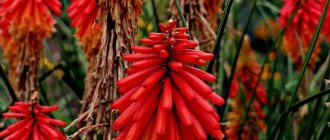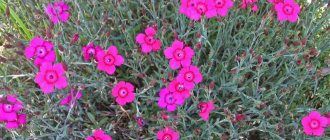When hearing the word “carnation,” many immediately imagine a scarlet, fragrant flower on long thin stalks - the official symbol of special occasions, the October Revolution and Victory Day.
But carnations are different, and today we will talk about other beautiful representatives of this numerous genus, which were undeservedly forgotten for some time, but are now returning in triumph to our flower beds. Charming miniature carnations
What is the secret of the charm of perennial carnations with small flowers? Why does changing garden fashion favorably turn its gaze to them again and again?
Ads by
Leadership Characteristics Set
Low-growing and small-flowered beauties can boast a number of advantages that are valued by summer residents as worth their weight in gold:
- bloom in the hottest period of summer,
- long-lasting flowering (until mid-late October with already serious frosts),
- one of the most drought-resistant garden plants,
- many species and varieties have a pleasant spicy aroma,
Cloves together with Byzantine sage and variegated varieties of Salvia officinalis in a rocky garden. Photo by the author
- bloom luxuriantly even on poor soils,
- tolerates lime-containing soils well,
- thanks to the bluish waxy coating on the leaves, they can withstand the scorching rays of the sun in the south,
- resistant to wind (strong stems do not break, they only bend under its gusts),
- are practically not damaged by naked slugs,
- a wealth of species and varieties of different colors to create borders, flower beds, tapeworms, Moorish lawns, rock gardens, rock walls, garden vases and containers.
Carnation in the wall of dry masonry.
Photo by the author Practical advice. Perennial carnations often emerge from wintering with a large number of dry leaves and shoots. If the plants are not old, there is no need to rejuvenate them; remove only the dead parts. Later, after flowering, when you remove faded flower stalks, trim more.
Small disadvantages are not a hindrance to takeoff
Perhaps some can be attributed to the peculiarities of cultivation, and only the last point can really cause some trouble for gardeners:
- Almost all adult species do not tolerate transplantation well,
- do not tolerate stagnant waterlogging of the soil and its compaction,
- there are no self-cleaning species and varieties (therefore, fading flower stalks must be removed in time to maintain the neat appearance of the plant).
Practical advice. To preserve their decorative appearance, perennial carnations are rejuvenated every 3-4 years, optimally at the end of summer.
Features of culture
All perennial carnations, which will be discussed below, are winter-hardy; in central Russia they overwinter without shelter. They bloom beautifully in open areas and in light partial shade. They prefer neutral and slightly alkaline soils. Quite drought-resistant, but in hot and dry summers watering is required. Propagated by seeds through seedlings.
Nuances of seed propagation
Seed collection is often carried out already in the 2nd ten days of August, at the beginning of the yellowing of the boxes.
Cut shoots are tied in bunches and hung in a ventilated area. The peduncles of the pinnate carnation have not yet turned yellow - it is too early to cut them for seeds. Photo by the author
When the boxes begin to open, the seeds are cleaned. In mid-March they are sown, planted shallowly, under a film, in a greenhouse. The substrate is prepared from leaf, turf soil and sand, taken in equal proportions. At a temperature of +20°C, seedlings appear on the 6-12th day. The pick is being carried out. when the first true leaves appear. The seedlings are ventilated, watered and fed once a week with a weak solution of mineral fertilizers.
Description and photo
All varieties of the Lilipot series are dwarf (not higher than 25 cm). They grow in the form of a bush and are characterized by intensive stem formation. The carnation is compact and does not require pinching of the tops in the initial stage of development.
The growing season of the plant lasts for five months. The varieties bloom after sowing seeds in February in June; in open ground the cycle lasts until October. In greenhouses, the Lilipot carnation can bloom throughout the year.
External characteristics of clove habit:
- the stems are erect, very densely spaced, light green, can have single buds or branch at the crown into 2–3 short peduncles;
- the leaves are narrow, elongated, with pointed tips and smooth edges. The main concentration is observed at the base of the bush. They are smaller along the stem, sessile, alternate, dark green with a blue tint;
- the root system is taprooted, deepened by 20–30 cm;
- The flowers are double, with rounded petals and finely toothed edges. Their diameter is 6 cm.
Important! Lillipot cloves have a distinct spicy aroma. This factor is taken into account when growing crops indoors.
Frost resistance
The frost resistance of the Lillipot series is average; it can winter without shelter in a climate zone where temperatures do not drop below -10 C. In gardens they are grown only in open areas; carnations are heat-loving with good drought resistance. Carnation Lilipot tolerates short-term water deficits better than constant waterlogging of the soil. The soil for planting must be fertile and slightly acidic.
How it blooms
There are several varieties of Lilipot carnations, which differ in the color of the inflorescences. Seeds of both individual varieties and mixtures are available for sale.
The main varieties of Lilipot carnations:
- white;
- lavender pink;
- light lilac;
- scarlet;
- orange;
- lilac;
- yellow.
Carnation produces large double flowers with a diameter of up to 6 cm. Flowering lasts continuously throughout the summer. By eliminating fading inflorescences, the formation of new buds is stimulated.
The growing season of the plant ranges from 16 to 20 weeks. The flower is grown as an annual or biennial plant. Inflorescences form 5-6 months after seed germination.
Garden carnation Lilipot - perennial or annual plant
According to its biological characteristics, the Lilipot variety is a perennial crop. The life cycle of the plant is 5 years. In the open ground of the subtropical zone and indoors, cloves are grown until they age.
Important! The only representative of dwarf varieties that can be grown as a perennial in all climatic zones is the Lilipot Purple F1 carnation. It is frost-resistant down to -24 C.
History of selection
A hybrid variety of the Lillipot culture was created on the basis of the Japanese company Sakata. The variety is based on wild Chinese carnation. The corporation is the copyright holder and supplier of seeds worldwide. The Lillipot series is a genetically dwarf form that does not require correction of growth in height and width, adapted to sudden changes in weather. The group includes varieties with various colors of large double flowers. Carnation Lillipot is recommended for growing in open ground, flower pots, and greenhouses.
Briefly about the main thing:
- Perennial.
- A series of genetically dwarf carnations.
- Height 25 cm.
- Forms numerous flowers all summer.
- Remains short and compact without pinching or the use of growth regulators.
A colorful plant for gardens and patios, containers and flowerpots. Can be grown as a potted crop (pot diameter 10-15 cm).
History of selection
A hybrid variety of the Lillipot culture was created on the basis of the Japanese company Sakata. The variety is based on wild Chinese carnation. The corporation is the copyright holder and supplier of seeds worldwide. The Lillipot series is a genetically dwarf form that does not require correction of growth in height and width, adapted to sudden changes in weather. The group includes varieties with various colors of large double flowers. Carnation Lillipot is recommended for growing in open ground, flower pots, and greenhouses.
Landing
Seeds are planted from January to April to ensure flowering of the bush in the summer. To force plants by the beginning of spring, seeds are planted in July-August.
- Boxes intended for growing seedlings are filled with soil. The soil is compacted and moistened with warm water from a spray bottle.
- It is convenient to plant seeds in cassettes measuring 2x2 cm. Then the seedlings do not require picking.
- Clove seeds are stored in the refrigerator. A day before planting, they are transferred to a warm place.
- Planting material is placed on the soil surface in increments of 2 cm. When using cassettes, one seed is placed in each cell.
- Carnation Lillipot germinates in good light. Therefore, the seeds are pressed into the soil or a thin layer of earth is poured on top.
The plantings are covered with plastic film. Turn it over periodically to remove condensation. Seed germination occurs at temperatures from +18 to +20 °C. The first shoots will appear in a week.
When to plant in the ground
In May-June, the Lillipot carnation is transferred to an open area. The plant prefers lighted places and light fertile soil. Carnations are planted on rocky and sandy soils. The flower actively develops next to stones that heat up in the sun.
In order for the plants to quickly adapt to natural conditions, they are hardened off in the fresh air 3 weeks before planting. In a room with plantings, open a window or move the boxes to the balcony.
Procedure for transplanting Lillipot carnations:
- Preparation of planting holes in increments of 10-15 cm.
- Abundant watering of plants.
- Transferring cloves without destroying the earthen clod and burying it.
- Covering the roots with soil and watering them abundantly.
For transplantation, choose the morning or evening period; during the day, work is carried out in cloudy weather. It is not recommended to bury seedlings, otherwise the plant will begin to hurt and may die.
How to preserve cloves in winter
In order to enjoy the beauty of carnations next year, but without unnecessary problems, you can save the bushes in the winter and then make cuttings from them.
The strongest and healthiest bushes must be cut and placed in a pot along with a lump of earth. They should be stored in a cool place
How to cut carnations in spring? Cuttings of carnations in the spring should occur in the following stages:
- Cuttings are made from the part located in the middle; the cuts should be in the internodes; make sure that the cuts are oblique;
- The lower leaves are removed, and the cuttings are treated with a disinfecting solution;
- The cuttings are planted in boxes that must be filled with sand;
- Cover the cuttings with a clear plastic bag.
New leaves and roots will begin to appear in a few weeks, but do not forget to open the bag for a few minutes during the first two weeks, this procedure must be done every day.
Reproduction
Cloves are propagated vegetatively and generatively. The structure of the root system does not allow dividing the mother bush into parts; if you try, the old plant may die and the plot may not take root. You can propagate the perennial carnation Lillipot by layering, but the method is not very effective, because the material obtained is small and it does not take root well after cutting. Cuttings are used more often.
Important! The optimal reproduction option is generative.
Propagation of Lilipot carnation by seeds
The Lilipot variety is grown by seedlings or by sowing seeds in the ground. The second option is only possible in warm climates. Preliminary receipt of planting material will speed up the budding time and eliminate the possibility of seedlings being damaged by return frosts.
In the subtropical climate of the south, seeds are sown in open ground at the end of March, when the temperature reaches +8 C. In July, the crop will bloom. Garden carnation Lilipot Purple is an early flowering variety, therefore it is recommended to grow it only from purchased seeds in seedlings. The hybrid does not produce complete material; the flowers are sterile.
When propagated by seeds, Lillipot carnations are planted in slightly acidic soil. The soil chosen is light, peaty, and weakly acidic. It is recommended to take soil from a garden plot or purchase ready-made flower soil.
Propagation of Lilipot carnation by cuttings
Cuttings are prepared from the first stems whose inflorescences have dried. Select an area with three vegetative buds. They cut at an angle, in the lower part a vertical cut with a depth of 0.5 cm is made in the center. In warm climates, Lilipot carnation cuttings are placed in fertile substrate on the site and a mini-greenhouse is installed. The structure is covered for the winter, and in the spring the rooted material is planted in a designated area.
Advice! Before placing the cuttings in the soil, cut off the lower leaves, leaving 2 at the top.
In cold climates, plant in a container with a nutrient mixture, cover with film, and constantly ventilate. For the winter they are brought indoors. Cuttings of Lilipot carnations are rarely practiced; this method is more labor-intensive and less effective than sowing seeds.
Garden carnation Lilipot - perennial or annual plant
According to its biological characteristics, the Lilipot variety is a perennial crop. The life cycle of the plant is 5 years. In the open ground of the subtropical zone and indoors, cloves are grown until they age. Taking into account the low frost resistance in the Middle and Central zone, Lilipot carnation can be cultivated as a two-year crop. In Siberia and the Urals, the garden plant does not overwinter; in the fall, after flowering has completed, it is completely removed from the site. Cloves are grown in greenhouses as annuals.
Important! The only representative of dwarf varieties that can be grown as a perennial in all climatic zones is the Lilipot Purple F1 carnation. It is frost-resistant down to -24 C.
Seedling care
After emergence of seedlings, the film is removed, and young plants are provided with partial shade. To prevent seedlings from stretching, the temperature is lowered to +15 °C.
When propagated by seeds, the Lilipot carnation is provided with certain care:
- regular ventilation;
- watering with warm water;
- feeding when 2 leaves appear with a solution of calcium nitrate in the amount of 1 g per 1 liter of water;
- continuous lighting for 14-18 hours.
To get a branched and compact bush, seedlings are pinched above the second pair of leaves. The top can be rooted to produce another plant.
After 6-7 weeks, the plants are transplanted into containers 9-10 cm high. The substrate is obtained from peat, light soil, humus and river sand in a ratio of 3:1:1:1. After 10 days, the plants are fed with potassium nitrate. For 10 liters of water, take 15 g of fertilizer.
Watering
Carnations are watered moderately when the top layer of soil dries out; during drought, plants require more moisture. For irrigation, take warm, settled water and apply it at the root. Watering is left in the morning or evening hours, when there is no direct sunlight.
After adding moisture, the soil is loosened to ensure oxygen access to the roots. After loosening, the absorption of moisture and nutrients by cloves improves.
Top dressing
Regular feeding helps stimulate the formation of new shoots. For processing, take complex flower fertilizer and dilute it with water. Cloves are watered with a nutrient solution every 10 days.
Growing and care
The main task when propagating Lillipot carnations is to obtain viable planting material. In order for the work carried out to be effective, it is recommended that certain rules be followed.
Sowing dates for Lillipot cloves
Throughout the year, Lilipot carnation seeds are sown in greenhouses for seedlings. When the first batch goes for sale, the next one grows. Sow in open ground at the beginning of the season or in October; this method is only applicable for warm climates. The autumn bed is not watered after planting. As soon as the sprouts appear in the spring, arcs are installed and grown until the temperature reaches above zero. Then the structure is removed.
To obtain seedlings in the south, seeds are planted in early February, in the Central regions - in mid-March, for the Siberian regions April is recommended
Soil and seed preparation
Purchased seeds are treated with antifungal agents before sale. Growth stimulants are not used for Lillipot carnations. All varieties of dwarf crops are hybrids, so there is no point in collecting seeds, since they do not sprout.
The soil for seedlings is purchased ready-made or peat, sand and compost are mixed, adding nitrophoska and potassium sulfate. Fill containers with substrate and water with hot manganese solution.
Planting Lilipot carnations with seeds and caring for seedlings
You can sow the seeds in small furrows or scatter them over the surface and lightly cover them with soil and compact them. After planting, the surface is watered and covered with film.
Seedling care:
- The containers are left until growth appears. Every day the film is lifted for ventilation.
- If the soil surface is dry, moisten it with a spray bottle.
- After emergence of shoots, the material is removed. Provide seedlings with 18 hours of daylight.
- Grown at a temperature of +18–20 C.
Water as needed to prevent stagnation of water. Before planting on the site, the plant is hardened off.
Clove seeds can be sown in separate containers
Planting in open ground and subsequent care
At the beginning of the season (approximately in the middle or end of May), Lilipot is planted on the site. The bed is first dug up, nitrophoska, compost and potassium nitrate are added to the soil.
Planting pattern:
- The cloves are transferred into the hole by transshipment without violating the integrity of the earthen coma.
- The recess is made in accordance with the size of the root. If the crop is perennial, the hole is made 15 cm deeper and covered with a drainage pad.
- Place cloves and cover with soil.
- Lightly compact and water generously.
Read more How to grow Turkish cloves from seeds at home
Cover the soil around the seedling with mulch. A good option is coniferous wood chips, it will acidify the composition and retain moisture. For linear planting, the distance between cloves is 15–20 cm.
Subsequent agricultural technology consists of the following activities:
- During the dry season, water the cloves with 10 liters of water every 3-4 days.
- Dry buds are cut off.
- Feed 10 days after planting with nitrophoska, when the first buds appear, with superphosphate. During flowering, use “Agricola for flowering plants”.
Around the beginning of August, liquid organic fertilizer is applied at the root. If the Lilipot carnation is left to overwinter, compost is added along with the mulch.
Wintering in different regions
When grown as an annual in the fall, the cloves are dug up along with the roots when the last inflorescences wither. It is recommended to burn the plant to prevent the spread of diseases and pests.
The flower tolerates cold temperatures down to -10 °C. Under snow cover, the plant can withstand frosts down to -27 °C.
When grown in warm climates, it is left without shelter. Before wintering, dry shoots and inflorescences of the Lilipot carnation are cut off.
Advice! In cold climates, it is recommended to cover the bushes with dry leaves, spruce branches or agrofibre.
Another option for overwintering Lilipot carnations is to dig up a bush and plant it in a pot. The shoots are pruned and the flower is kept at home. In winter, the intensity of watering is reduced and fertilizing is not performed. In spring, carnations are transferred to open ground.
General information about the plant
Many species are cultivated as ornamental plants: carnations are used in landscape design and in bouquets. Dianthus is classified as a herb and sometimes as a low-growing shrub.
Leaves are linear or linear-lanceolate. The flowers are often solitary, with 5 petals, 2 styles, 10 stamens and a cylindrical calyx. There are types of carnations whose flowers are collected in inflorescences. Petals come in a wide variety of shapes: smooth, corrugated, fringed, with a torn or wavy edge.
The stem is smooth and knotty, green, blue or bluish in color. Depending on the variety, the length of the stem varies from 5 to 100 cm. The fruit is a cylindrical capsule with black oval seeds.
Annual Chianti carnation
The stem of the carnation is distinguished by two types of shoots: flowering and vegetative, which are much shorter than the first.
The variety of colors is constantly increasing thanks to hybrid varieties. In addition to the classic scarlet carnation, you can find pink, lilac, white and even green flowers. Multi-colored and velvety varieties of all shades of the rainbow seem especially impressive.
Carnation blooms from early summer to late autumn. Many species emit a characteristic pleasant aroma.
Advantages and disadvantages
The Lilipot series is the most popular of the short-growing representatives of the culture. It has earned its popularity due to a number of qualities:
- the flowers are large, double, with a pleasant aroma and all kinds of colors;
- long and continuous flowering period;
- the bush is compact, dense, does not require correction;
- suitable for forcing and hanging cultivation;
- unpretentious agricultural technology;
- grows in pots as an indoor seedling;
- universal use in design;
- good stress resistance;
- tolerates minor spring frosts without loss;
- does not require constant watering.
The disadvantages of the dwarf variety Lilipot include poor frost resistance, demanding soil composition and susceptibility to fungal infections.
General information
The term “garden carnation” refers to a large group of plants belonging to the Carnation family. Most of them are perennial flowering herbs that came from the Mediterranean. Some were bred artificially through hybridization. In our latitudes it is grown as an annual or biennial plant.
Garden carnation grows as a shrub; The shoots are branched, thin, their height reaches 60 cm. The lower part can become woody with age, which makes the carnation look like a subshrub. The leaves are entire, linear or linear-lanceolate, pointed at the end, arranged oppositely; green, sometimes covered with a bluish-green coating. The root system is superficial and poorly developed. Flowers can be single, up to 5-6 cm in diameter, or collected in complex umbrellas. The shape and color of the corolla depend on the variety. Flowering is summer, in some varieties it continues until October.
Problems when growing cloves
Carnation lilipot is susceptible to the following diseases:
- Bacterial wilt - the tops of the stems turn gray and wither, the bush does not grow taller. The leaves gradually shrink and the roots die. Pale brown vessels are visible on the stem. Affected bushes are removed. The spread of the disease is combated with the help of biological products.
- Phialophorosis - the plant completely turns yellow and withers. The defeat starts from the bottom. On the cut of the shoots, brown spots or rings can be distinguished. The disease cannot be cured, so the affected clove bushes are removed and they are no longer planted in this place.
- Fusarium wilt - caused by a fungus, first the leaves turn yellow, then the entire plant. Gradually the bush dies. A cut of a dry stem clearly shows the brown vessels. Rot forms inside the shoots. The fungus spreads well in acidic soils and high humidity conditions. For prevention, cloves are treated with special preparations (Baktofit).
- Brown rot - affects mainly young plants; brown spots, slightly depressed, form on them. High humidity promotes the spread of the disease. White threads of mycelium become visible on the soil. Prevention and treatment are carried out with biological products.
- White rot - the plant withers and dark spots appear on it with white mycelium inside. Sick bushes are burned and the rest of the plantings are treated with special preparations.
- Alternaria blight - gray spots bordered with brown form on the leaves between the veins. Gradually they merge into one, and the plant eventually dies. If a disease is detected, the affected bushes are destroyed, the humidity in the planting area is reduced and treated with special preparations.
- Rust is a fungus that leads to the formation of light spots on shoots and leaves, on the back of which brown bumps appear. Bordeaux mixture and special modern remedies will help against the disease.
Low-growing varieties of carnations
Low varieties of carnations are most often used to decorate garden paths and borders; they are grown in rocky gardens and in closed containers. There are several most popular varieties of culture.
Haytor
The compact carnation, up to 15 cm in height, is unpretentious and grows well in summer cottages and in urban areas. The advantages of the species include winter hardiness and strong immunity. The variety is grown in flower beds and in alpine hills, used for cutting - the buds do not fade for a long time in water. For successful development, carnations should receive only a moderate amount of moisture and regular feeding.
The buds of the Heitor variety are terry, white, with a pleasant aroma. They bloom in early June and remain attractive until September.
You can grow Heitor carnation in bright sun, as it does not fade under its rays.
Splendens
The hardy species of perennial carnation is one of the most beautiful and unpretentious ground covers. The variety is used to decorate paths and rocky gardens, and to decorate lawns. The buds of the plant are small, bright crimson-red. Flowering continues from June to September, while the perennial carnation easily tolerates the first frosts and does not lose its attractiveness.
Carnation Splendence grows to a maximum of 15 cm in height
Spring Beauty
Beautiful perennial carnations up to 30 cm tall are used when decorating ridges, flower beds and alpine slides. Bears small buds with rugged petals, soft pink with a crimson core. It grows well and quickly, forming low but dense bushes. Prefers soils that are light and dry, with sand in the composition and with a neutral reaction.
The flowering of the perennial Spring Beauty carnation begins at the end of May and lasts until mid-August
White Ladies
The snow-white carnation rises to an average of 25 cm above the ground. The petals of the perennial species are double, with a serrated edge, the middle is slightly greenish. During the decorative period, the plant emits a strong aroma. It begins to bloom in June and remains attractive until autumn.
With high-quality care, the perennial variety White Ladies tolerates frosts down to -35 ° C
Leuchtfunk
The low perennial carnation blooms in warm weather in early June and retains its beauty until August. The flowers of this species are fiery red, very abundant, although small in size.
Attention! The perennial crop grows quickly and forms full-fledged carpets in the areas allocated for it.
The height of the Leuchtfink carnation reaches a maximum of 15 cm
Coconut Sundae
A perennial, spreading carnation with lodging thin stems and blue-gray leaves, it blooms between June and July. Grows to a maximum of 20 cm, prefers well-drained soil and sunny areas in the garden. The inflorescences of the variety are double, large, white in color with a red core. The variety emits a light, pleasant aroma.
Perennial carnation Coconut Sunday easily takes root by layering and quickly spreads throughout the area
Pests
The following harmful insects can be found on cloves:
- Spider mite - its size is up to 0.5 mm, lives on the back of the leaves in the web it weaves. Plants develop speckles of yellowish color followed by large discolored and dried out areas. The insect prefers dry and hot weather. A soap solution helps against ticks, and in case of severe infestation, special preparations (Fitoverm, Molniya).
- Leaf miner - makes tiny holes in leaf blades. This injures the carnation and in case of large concentrations of pests, the bush may die. Plants on which there are especially many pests are destroyed. The rest of the plantings are treated with products like Actellik and Fufanon.
- Spring fly - attacks shoots located in the center of the bush, gradually they dry out and rot. The larvae, 6-8 mm in size, make passages inside the stem, thereby leading to the death of the plant. A good preventative measure would be to loosen the soil near the bushes, and treat cloves with special preparations.
- Thrips - lead to deformation of leaves, especially young ones. Flowers become spotted, the edges of the petals darken. Thrips reproduce in buds next to the stamens. Sticky traps are used against them, which are placed in greenhouses to protect very young plants. Plantings are sprayed with insecticides at intervals of 5-6 days.
When to sow cloves for seedlings, in what month
If you really like carnations and want to plant them in your garden or vegetable garden, then most likely you are wondering when to sow cloves?
The best time to sow carnations is the end of January or the first days of February; some flower beds sow them in early March, but you don’t need to do this too late. The plant needs quite a long time to develop normally.
You also need to take into account the climatic characteristics of your region, for example, the optimal time for sowing in Moscow is mid-February, and in the southern regions the last days of January are suitable.
You can navigate according to the lunar calendar, this is very convenient, because you can immediately determine both favorable and unlucky days
Days on which it is best to sow seedlings:
- January – 27-29;
- February – 1-8, 10-20, 25-28;
- March – 2-14, 29-31;
- April – 1, 2, 5, 6, 7, 9, 18-20, 24, 25.
Days on which it is strictly forbidden to work in the garden:
- January – 10, 25,26;
- February – 9, 21, 22, 23;
- March – 9, 19, 20, 21,24;
- April – 8, 15,16, 17,23.
Varieties and hybrids
A series of hybrids of low-growing Dutch carnations, grown as a perennial crop in mild winters, and when grown through seedlings, blooms in the first year starting in July. The bushes are compact, 20–25 cm high, with long bluish leaves and large double flowers up to 6 cm in diameter. The series includes several very interesting forms:
- Lillipot F1 Scarlet – catchy, fiery red;
- Lillipot F1 Lavande Pink – lavender pink;
- Lillipot F1 Orange (Lillipot F1 Orange Bicolour) – rich orange;
- Lillipot F1 White – boiling white, exquisite.
Lilipot F1 hybrids look stunning in mixborders and flower beds, in containers and on balconies, and also decorate rooms when planted in pots.
Application in landscape design
The Japanese dwarf line is universal in use. Low-growing compact bushes are characterized by abundant and long-lasting flowering. Garden carnation Lillipot (pictured) can be used in any design idea:
- for creating borders;
- decorating open verandas and balconies;
- create compositions with low-growing flowering plants;
- decorate alpine slides, mixborders;
- decorate flower beds and use them as an option for edging lawns.
Hello, dear readers!
Just one breath - and sorrows are forgotten! What colors do you think this can be said about?
Of course, about the tart, teasing and exciting aroma of cloves. This smell is like a bundle of energy, inhalation and laughter already sparkling in the eyes.
Inhaling further without stopping, we become intoxicated with the feeling of joy, life, love. And it doesn’t matter that the morning was cloudy, and the day as a whole was not going well - all this is already in the past.
It’s not without reason that the Latin name of the carnation is translated as “divine flower.”
Many legends are associated with the carnation, a plant that decorates many gardens and front gardens and is well known to gardeners.
From romantic to terrifyingly bloody. And the associations are different: for some, flowers will bring back tender memories, for others they will evoke bitter emotions. And all this is her, the carnation. Native of different places.
Carnations are like people: representatives of the same species, but have different homelands.
The garden carnation traces its lineage to the Mediterranean. Its wild relatives grow there.
Chinese - Chinese, the homeland of some of its subspecies is Japan.
There is also our original, Primorsky Chinese carnation. Such an incident with the name of the species is called Chinese, and the origin is “international”.
The territorial proximity of these regions determined the similarity of their climate and contributed to the spread of cloves.











